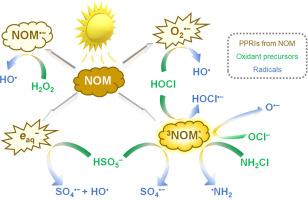Making waves: Sustainable control of micropollutants via NOM-mediated photosensitized activation of oxidants
IF 12.4
1区 环境科学与生态学
Q1 ENGINEERING, ENVIRONMENTAL
引用次数: 0
Abstract
While photo-based advanced oxidation processes (AOPs) are promising for the abatement of micropollutants in water and wastewater, they are inevitably influenced by the components of the background water matrix. As one of the major water matrix components, natural organic matter (NOM) generates photochemically produced reactive intermediates (PPRIs, e.g., 3NOM* and NOM•−) upon photolysis. PPRIs have recently been found to activate oxidants (e.g., H2O2) and generate reactive species (e.g., HO•), offering a novel and sustainable approach to degrade micropollutants in water. To facilitate the application of this NOM-mediated process, we summarize the fundamentals from the relevant literature, including PPRI generation, the mechanism of photosensitized activation of oxidants, performance of the processes for micropollutant degradation, and the factors influencing photosensitized activation. NOM•− is the PPRI activating H2O2 whereas the rest of the oxidants are primarily activated by 3NOM*. Resulting from the photosensitized activation, NOM and oxidant can exhibit synergism for micropollutant degradation under solar irradiation. Various factors, such as NOM properties, irradiation wavelength, pH, and other water matrix components (e.g., inorganic carbon and metal ions), affect the efficiency of photosensitized activation. Accordingly, we identify several future research directions: (1) investigating the wavelength dependency of photosensitized activation, (2) manipulating NOM structures in pre-treated processes, and (3) evaluating the formation of undesired byproducts.


掀起波澜:通过一氧化氮介导的氧化剂光敏活化对微污染物的可持续控制
虽然基于光的高级氧化工艺(AOPs)有望减少水和废水中的微污染物,但它们不可避免地受到背景水基质成分的影响。天然有机物质(natural organic matter, NOM)作为水基质的主要成分之一,通过光解作用产生光化学生成的反应中间体(ppri),如3NOM*和NOM•−。ppri最近被发现可以激活氧化剂(如H2O2)并产生活性物质(如HO•),为降解水中微污染物提供了一种新的可持续方法。为了促进这一过程的应用,我们从相关文献中总结了PPRI的产生、氧化剂光敏活化的机制、微污染物降解过程的性能以及影响光敏活化的因素。NOM•−是激活H2O2的PPRI,而其余的氧化剂主要被3NOM*激活。由于光敏活化,在太阳照射下,NOM和氧化剂可以协同降解微污染物。各种因素,如NOM性质、辐照波长、pH和其他水基质成分(如无机碳和金属离子)都会影响光敏活化的效率。因此,我们确定了几个未来的研究方向:(1)研究光敏活化的波长依赖性;(2)在预处理过程中操纵NOM结构;(3)评估不良副产物的形成。
本文章由计算机程序翻译,如有差异,请以英文原文为准。
求助全文
约1分钟内获得全文
求助全文
来源期刊

Water Research
环境科学-工程:环境
CiteScore
20.80
自引率
9.40%
发文量
1307
审稿时长
38 days
期刊介绍:
Water Research, along with its open access companion journal Water Research X, serves as a platform for publishing original research papers covering various aspects of the science and technology related to the anthropogenic water cycle, water quality, and its management worldwide. The audience targeted by the journal comprises biologists, chemical engineers, chemists, civil engineers, environmental engineers, limnologists, and microbiologists. The scope of the journal include:
•Treatment processes for water and wastewaters (municipal, agricultural, industrial, and on-site treatment), including resource recovery and residuals management;
•Urban hydrology including sewer systems, stormwater management, and green infrastructure;
•Drinking water treatment and distribution;
•Potable and non-potable water reuse;
•Sanitation, public health, and risk assessment;
•Anaerobic digestion, solid and hazardous waste management, including source characterization and the effects and control of leachates and gaseous emissions;
•Contaminants (chemical, microbial, anthropogenic particles such as nanoparticles or microplastics) and related water quality sensing, monitoring, fate, and assessment;
•Anthropogenic impacts on inland, tidal, coastal and urban waters, focusing on surface and ground waters, and point and non-point sources of pollution;
•Environmental restoration, linked to surface water, groundwater and groundwater remediation;
•Analysis of the interfaces between sediments and water, and between water and atmosphere, focusing specifically on anthropogenic impacts;
•Mathematical modelling, systems analysis, machine learning, and beneficial use of big data related to the anthropogenic water cycle;
•Socio-economic, policy, and regulations studies.
 求助内容:
求助内容: 应助结果提醒方式:
应助结果提醒方式:


